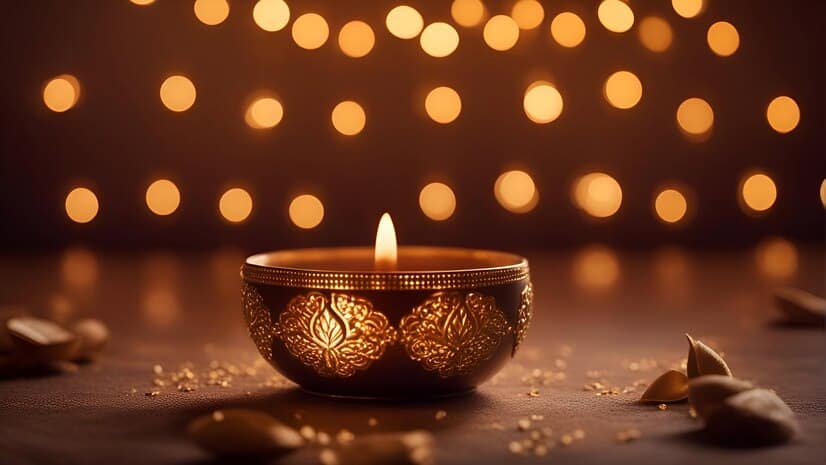
Informative
Yama Dwitiya
When you hear the word “Yama,” what do you think of? Probably a robust figure wearing a crown adorned with horns, sporting a heavy mustache, holding a lasso and mace while riding a buffalo, delivering ominous tidings, right? For centuries, Lord Yama has been known as the bringer of bad news, tasked with binding the souls of the departed and transporting them to his abode for judgment and punishment.
Now, all of you know that in Sanatana Dharma, Diwali is considered as one of the most auspicious and joyous occasions to celebrate. However, it may surprise you to learn that one day of the Diwali festivities is dedicated to this ominous, so-called god of death. In this blog, we aim to delve into the origins, spiritual significance, and the practice of Sadhana associated with celebrating Yama Dwitiya. Let’s get started!
Yama and Yami
According to a tale from the Markandeya Purana, Vishwakarma (the architect of the gods) had a beautiful daughter named Sangya. One day, Sangya married the powerful Sun god, Surya.
But there was a problem. When Sangya saw her husband’s dazzling radiance, she got scared and closed her eyes. This made Surya very angry, and in his anger, he cursed her. He said, “Your son will have the power to control people’s lives. He will be the fearsome one who guides souls after they pass away.”
Sangya felt upset about this curse, and she looked at Surya with uncertain eyes. In response, he added another aspect to the curse, saying, “The daughter you will have will also be influenced by fickleness, just like the way you look at me now.”
As time passed, Sangya gave birth to a son named Yama. He grew up to be the ruler of the afterlife, the one who decides what happens to souls after they die. And he was also blessed with a sister named Yami.
Yami, later known as the holy Yamuna river, embodied the fickle nature as her mother’s curse predicted. Both Yama and Yami played crucial roles in ancient Sanatana traditions and became well-known figures.
Origins of Yama Dwitiya
Yamuna loved her brother dearly and wanted to pray for his well-being and long life. So, she decided to observe a special feast for him. She invited Lord Yama to her home many times, but he was always busy with his duties and couldn’t make it. However, after some time, Lord Yama managed to find a moment to visit his sister. When he arrived, Yamuna showed him great respect and hospitality. She prepared a delicious meal and lovingly offered it to her brother.
This act of sisterly love and care pleased Lord Yama greatly. He was so touched by Yamuna’s devotion that he asked her to make a wish. Without hesitation, Yamuna asked for a special blessing. She requested that on this particular day, any brother who visits his sister’s house and shares a meal prepared by her would be spared from going to Naraka (hell). And not just that, Lord Yama also promised that any sister who invites her brother to her home on this day and serves him food will be blessed to never become a widow.
How to Celebrate Yama Dwitiya
Date and Time: Yama Dwitiya Puja is observed on the second day of the waxing phase of the moon (Shukla Paksha) in the month of Kartik, which usually falls during Diwali.
Auspicious Time: According to Hindu scriptures, the most suitable time for performing the Puja is during Aparahna, which is the afternoon period.
Yamuna Snan: Before starting the Puja, it is highly auspicious to take a bath in the Yamuna River or any other sacred water body, as it is believed to purify the devotee. Even if you do not live near any sacred water source, it’s recommended to take a bath in your house, before the Puja, assuming you are being purified by the sacred river Yamuna.
Puja Preparation: After the bath, get ready for the Puja by wearing clean and traditional attire. Arrange the Puja items, including flowers, incense sticks, lamps, water, sweets, fruits, and Vigrahas or paintings of Lord Yama and Lord Chitragupta. (Chitragupta is positioned next to Yama to chronicle the good and evil actions of all sentient beings.)
Deity Worship: Begin the Puja by offering prayers and reciting mantras in reverence to Lord Yama, the God of death, and Lord Chitragupta. For the mantras, we recommend you consult your Guruji, as they are the best source of the most suitable mantra for you.
Arghya Offering: During the Puja, offer Arghya (water mixed with rice and flowers) to Lord Yama as a gesture of respect and devotion.
Blessings and Protection: It is believed that worshiping Lord Yama on this occasion helps protect devotees from untimely death and grants them blessings for a long and prosperous life.
Traditions: Yama Dwitiya is also associated with the tradition of sisters applying Tilak on their brothers’ foreheads. Sisters offer sweets to their brothers and pray for their well-being and longevity.
Remember to perform the Puja with devotion and sincerity, seeking blessings from Lord Yama for a blessed and protected life.
Spiritual Significance of Yama Dwitiya Celebrations
Worshiping Lord Yama and Lord Chitragupta on the auspicious day of Yama Dwitiya holds deep spiritual significance in Hindu tradition. Devotees seek blessings for a long and prosperous life, as well as liberation from the cycle of birth and death (Moksha).
Lord Yama is revered as the god of death, responsible for guiding souls after death, while Lord Chitragupta is believed to be the divine scribe who keeps records of people’s deeds and karma. By worshiping these deities together, devotees seek protection from untimely death and strive to lead a righteous life, knowing that their actions are being recorded and accounted for.
This day serves as a reminder of the impermanence of life and encourages individuals to embrace spirituality and seek self-improvement. The Puja on Yama Dwitiya helps devotees understand the significance of karma and its influence on their present and future lives.
It is a time for introspection, where people assess their actions and resolve to make positive changes in their behavior and choices. The worship of Lord Yama and Lord Chitragupta fosters a sense of accountability for one’s actions and the consequences they may bring.
We hope this blog has shed light on the spiritual significance of worshiping Lord Yama and Lord Chitragupta on the auspicious day of Yama Dwitiya. As we celebrate this occasion, let us embrace the teachings of karma, acknowledging the importance of our actions and their consequences.
On this special day, let us also cherish the beautiful bond between brothers and sisters, and may the tradition of Bhai Dooj strengthen the love and respect within our families. We wish you all a blessed and joyous Yama Dwitiya, filled with love, harmony, and spiritual enlightenment. May the grace of Lord Yama and Lord Chitragupta guide us on our path towards wisdom and liberation.
Seeking guidance from spiritual experts is imperative to get that unique mantra, meditation, and spiritual method crafted exclusively for you for the spiritual awakening you seek. And hence, we recommend you practice these interpretations and practices mentioned above under the guidance of an expert.
Please subscribe to our mailing list to stay connected and receive spiritual information. In case of any queries, please write to us at info@chamundaswamiji.com. You can check out our YouTube channel Chamunda Swamiji where you can learn Tantra, Mantra, Yantra, and Meditation from His Holiness Shri Chamunda Swamiji. If you seek to learn Shakti Kriya, please register with us, and we will get back to you.
Post a Comment
-
Subscribe to Our Blog
-
Categories
-
Popular Articles
- Dead moth in the house. What universe is trying to tell you?
- Spiritual Meaning of Moth
- Vivah Bandhan Curse – What Is It and How to Spiritually Heal It.
- The Dasa Mahavidyas
- What are Beej Mantras?
- Tripura Sundari | The Dasa Mahavidya
- Maa Bhuvaneshwari | The Dasa Mahavidyas
- The Five Shades of Tantra
- Ramakrishna Paramhansa – The Man who almost became a Woman
- Maa Chinnamasta | The Dasa Mahavidyas



